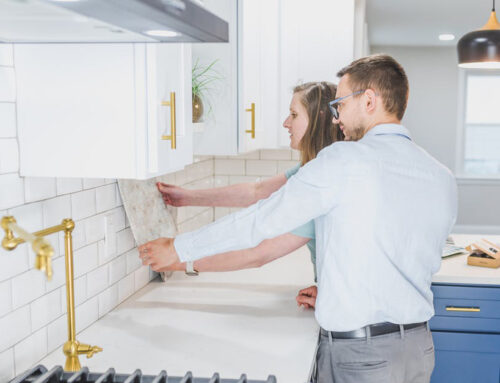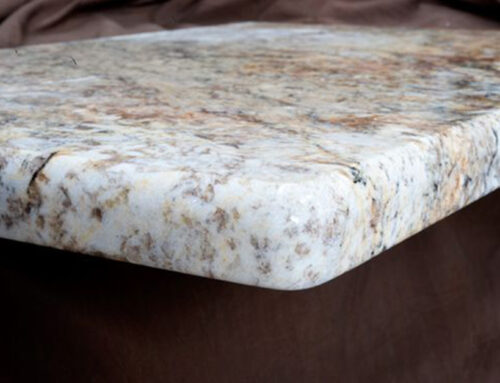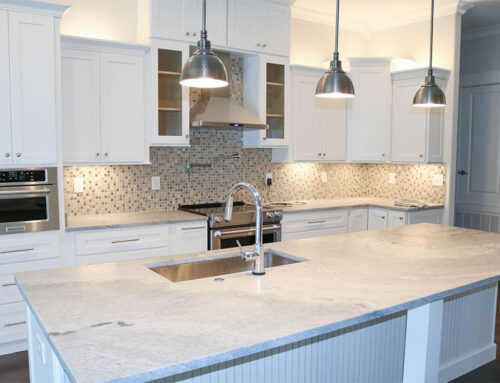If you are looking for a countertop with the beauty of marble and the durability and hardness of granite, look no further than quartzite. It is aesthetically pleasing and easy to take care of. It is nearly indestructible and will last a long time with the proper care. Knowing the features of this stone will help you understand how to clean quartzite countertops, so they look and perform optimally.
What is Quartzite?
Beginning as sand pressed together by pressure and heat in the earth, quartzite is a metamorphic rock made up almost entirely of the mineral quartz. It is often a lighter-colored stone, but additional mineral content can give it green, blue, or iron-red hues.
Use caution and a reputable supplier when choosing quartzite. Sometimes countertops labeled as quartzite are not genuine. A scratch test will ensure you are purchasing the real thing. If a countertop says quartz, it is often manufactured from crushed mineral quartz and resin. Quartzite, on the other hand, is cut from the earth.
Why Quartzite for Countertops?
- Minerals are ranked on a scale of hardness. Quartzite ranks a seven on the hardness scale compared to marble, which ranks a three. To compare, glass ranks around a five, and granite is six.
- Quartzite is resistant to acids. It is not likely to etch if you spill lemon juice or vinegar on your countertop. Depending on the material, acidic liquids can leak into the pores of the quartzite and cause stains, so care must be taken to clean up these spills promptly.
- Quartzite comes in varying porosity levels – meaning that, if untreated, it will absorb more liquids – shortening its life span. Particular countertops may need to be sealed depending on your application.
- You get the look of marble with the toughness of granite.
Should I Seal or Reseal my Quartzite Countertop?
Due to the porosity, if left unsealed, the natural pores in the stone could soak up liquids. Depending on your usage, some manufacturers recommend sealing your countertop every six months to two years. The quality of the sealant materials changes and varies among manufacturers, so it depends on the product you use.
Dark patches around the sink or water that doesn’t pool indicate it might be time to reseal your countertops. It’s an easy process that you can do at home. Follow the manufacturer’s instructions, but in general, they tell you first to clean the surface well and dry it thoroughly. Then spray on the sealant and wipe it into the surface. Ensure your area is well ventilated while applying and allowing the sealant to cure. The sealant is food-safe once it is dry.
Protecting Countertops
Prevention and quick clean-up are the best ways to protect any countertop, including quartzite.
- Use coasters for glasses and mugs. This will prevent water or liquid stains from even getting onto the surface.
- Clean up spills immediately, especially citrus, vinegar, juice, soda, wine, ketchup, or anything that can stain.
- Use cutting boards. Even though a dropped knife will probably not mar the surface, over time, using a knife on the bare surface will negatively affect the appearance.
- Use potholders or trivets under hot items.
- Wipe the countertop regularly of debris.
Cleaning Tips for Quartzite Countertops
Follow these cleaning guidelines to ensure longevity and keep your countertop looking beautiful.
- If your countertop is in a place that is not used often, a dusting or wiping with a damp cloth will generally suffice. Be careful using a dusting spray until you test it first.
- Clean up spills and water spots immediately with a soft cloth or paper towel.
- Use mild soap and water or stone-specific cleaners that will not strip the sealant.
- Dilute or concentrate your cleaner according to package directions to clean different items.
- Before using any new cleanser, do a spot test in a hidden corner to ensure it does not discolor or scratch the surface. You might ask your supplier for a scrap piece specifically for these types of tests.
- Use a commercial stain remover poultice or a homemade baking soda and water paste for stubborn stains. Spread it over the stain and cover it with plastic wrap for two days. You might require more than one application.
- You might need to scrape some stains or hard water deposits. Carefully use a small razor and gently scrape at an angle to prevent scratching the surface. Follow this up with a quartz cleaner.
- Buffing your countertops dry after cleaning will remove excess water or cleaners and keep a streak-free shine.
Cleaners to Avoid
Many cleaners on the market are too rough for Quartzite countertops. These include:
- Abrasive pads
- Highly acidic cleaners and homemade cleaners that use lemon or vinegar as a base
- Highly alkaline cleansers
- Oil-based soaps
- Cleaners with ammonia, alcohol, bleach, or acetone
- Cleansers with hydrofluoric acid
- Cleaners with foaming agents
- Oven cleaners are not designed for countertops
It’s best to stick with one made specifically for your countertop. There are plenty on the market that are eco-friendly or have disinfectant properties.
Want New Countertops for Your Austin Home?
At Phoenix Stone and Laminate, we’re experts in countertops of all sizes. If you are ready for a new countertop, we can talk to you about your space and recommend the perfect materials. We can also suggest cleaning materials that will keep your quartzite countertop looking great for years to come. Call us today with any cleaning questions or to discuss the variety of countertops available.






